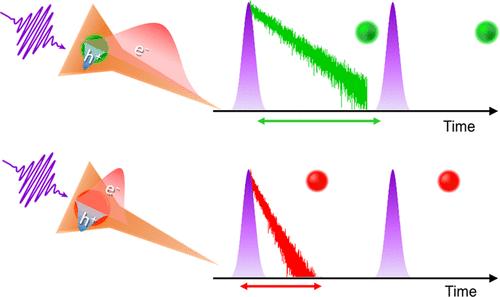当前位置:
X-MOL 学术
›
J. Phys. Chem. C
›
论文详情
Our official English website, www.x-mol.net, welcomes your feedback! (Note: you will need to create a separate account there.)
Optimizing Electron Delocalization in CdSe-CdS Heteronanostructures: Insights from Single-Particle Photoluminescence Studies
The Journal of Physical Chemistry C ( IF 3.3 ) Pub Date : 2024-06-15 , DOI: 10.1021/acs.jpcc.4c03159 Merin Varghese P. 1 , Amrutha Rajan 1 , E. Krishnan Vishnu 1 , Timi Titus 1, 2 , K. George Thomas 1, 2
The Journal of Physical Chemistry C ( IF 3.3 ) Pub Date : 2024-06-15 , DOI: 10.1021/acs.jpcc.4c03159 Merin Varghese P. 1 , Amrutha Rajan 1 , E. Krishnan Vishnu 1 , Timi Titus 1, 2 , K. George Thomas 1, 2
Affiliation

|
Developing semiconductor systems for light energy harvesting and photocatalysis necessitates the stabilization of photogenerated charge carriers. Achieving charge carrier separation in heteronanostructures involves the band engineering of two distinct semiconductors and extending the delocalization length of charge carriers. The radiative lifetime of the neutral exciton measures the extent of the charge delocalization. Nevertheless, the contributions of trap-assisted nonradiative decay channels significantly influence the overall radiative lifetime in ensemble measurements; hence, it is difficult to quantify charge carrier delocalization. Herein the radiative recombination dynamics of neutral exciton in heteronanostructures, comprising a CdSe quantum dot as core and a CdS shell with tadpole morphology (CdSe-CdS) are investigated through time-resolved single-particle spectroscopy. The CdSe-CdS system exhibits quasi-type II characteristics, resulting in the localization of a hole within the CdSe core, while the electron is predominantly delocalized between the CdSe core and the CdS shell. The neutral exciton recombination lifetime is determined by analyzing the high-intensity component in the photoluminescence intensity-time traces by varying the core size of the CdSe quantum dots and increasing the length of the CdS shell. These studies elucidate that electron delocalization is more efficient in CdSe-CdS heteronanostructures with a smaller CdSe core diameter and an extended CdS shell length.
中文翻译:

优化 CdSe-CdS 异质纳米结构中的电子离域:单粒子光致发光研究的见解
开发用于光能收集和光催化的半导体系统需要稳定光生电荷载流子。在异质纳米结构中实现载流子分离涉及两种不同半导体的能带工程以及延长载流子的离域长度。中性激子的辐射寿命衡量电荷离域的程度。然而,陷阱辅助非辐射衰变通道的贡献显着影响系综测量中的整体辐射寿命;因此,很难量化载流子离域。本文通过时间分辨单粒子光谱研究了异质纳米结构中中性激子的辐射复合动力学,该异质纳米结构包含 CdSe 量子点作为核心和具有蝌蚪形貌的 CdS 壳(CdSe-CdS)。 CdSe-CdS 体系表现出准 II 型特征,导致空穴位于 CdSe 核内,而电子主要在 CdSe 核和 CdS 壳之间离域。通过改变 CdSe 量子点的核尺寸和增加 CdS 壳的长度来分析光致发光强度-时间迹线中的高强度成分,确定中性激子复合寿命。这些研究表明,在具有较小 CdSe 核直径和较长 CdS 壳长度的 CdSe-CdS 异质纳米结构中,电子离域更加有效。
更新日期:2024-06-15
中文翻译:

优化 CdSe-CdS 异质纳米结构中的电子离域:单粒子光致发光研究的见解
开发用于光能收集和光催化的半导体系统需要稳定光生电荷载流子。在异质纳米结构中实现载流子分离涉及两种不同半导体的能带工程以及延长载流子的离域长度。中性激子的辐射寿命衡量电荷离域的程度。然而,陷阱辅助非辐射衰变通道的贡献显着影响系综测量中的整体辐射寿命;因此,很难量化载流子离域。本文通过时间分辨单粒子光谱研究了异质纳米结构中中性激子的辐射复合动力学,该异质纳米结构包含 CdSe 量子点作为核心和具有蝌蚪形貌的 CdS 壳(CdSe-CdS)。 CdSe-CdS 体系表现出准 II 型特征,导致空穴位于 CdSe 核内,而电子主要在 CdSe 核和 CdS 壳之间离域。通过改变 CdSe 量子点的核尺寸和增加 CdS 壳的长度来分析光致发光强度-时间迹线中的高强度成分,确定中性激子复合寿命。这些研究表明,在具有较小 CdSe 核直径和较长 CdS 壳长度的 CdSe-CdS 异质纳米结构中,电子离域更加有效。











































 京公网安备 11010802027423号
京公网安备 11010802027423号